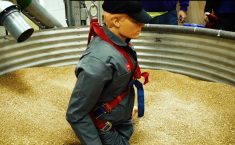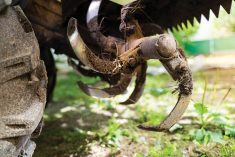Grain vacs are designed to make light work of what can often be a tedious chore. These high capacity and high efficiency (and high speed) machines can move thousands of bushels an hour (an upgrade from the shovel). Alongside the advances in grain moving technolog, come entrapment and engulfment hazards. Grain vacs are just like other pieces of farm equipment — there are hazards like moving and rotating parts, hitching hazards and transportation hazards.
Unlike a tractor, a grain vac might not get used very often. As such, it’s important to take the time to review operating procedures before starting work. Review the manual (and follow the manufacturer’s guidelines), check to make sure all shields are in place, perform maintenance and make sure the grain vac is in overall good repair. These steps will protect yourself and the investment in your equipment.
Read Also

Lower nitrogen rates in dry beans could pay off for farmers
Manitoba research is testing whether reduced nitrogen fertilizer in dry beans can maintain yields while cutting costs and lowering greenhouse gas emissions.
Grain entrapment and engulfment are caused by one thing: flowing (or moving) grain. A grain vac is designed to put grain in a state of motion, that is, to move grain quickly and efficiently. Unfortunately, this can lead to entrapment hazards (when a person becomes buried in grain beyond the point of getting themselves out), or worse, engulfment hazards (when a person is completely buried or submerged beneath the surface of the grain).
Consider the size of a human being. The average human body is only equivalent to a few bushels of grain. When an operator enters a grain bin or other flat storage surface to sweep a vac over grain, this can pose a serious entrapment risk.
The suction power of these devices is very strong. If the intake is dropped, the attachment can become buried in grain very quickly. If the operator tries to lift the intake out of the grain while the vac is on, this can cause the vac to suck up grain around their feet. The moving grain, acting like quicksand, draws the operator under, causing an entrapment.
The deeper an operator is buried, the more dire the situation. When buried up to the chest, every time the entrapped person breathes, grain flows into the space created by the movement of their chest. With each breath, pressure increases until breathing becomes impossible and suffocation can occur. If completely submerged, an entrapped person will suffocate in minutes.
While a grain vac is an efficient way to handle grain, it can become very dangerous if not used properly.
- Follow the safety precautions in the operator’s manual.
- Never work alone.
- Use extra caution when working with grain that is out of condition.
- Move the intake frequently, avoid forming a cone depression, keep the grain surface level and work from the outside wall and move inward.
Don’t put yourself at risk. Take every precaution necessary. It could save your life. For more information about grain safety, visit the Canadian Agricultural Safety Association website.















